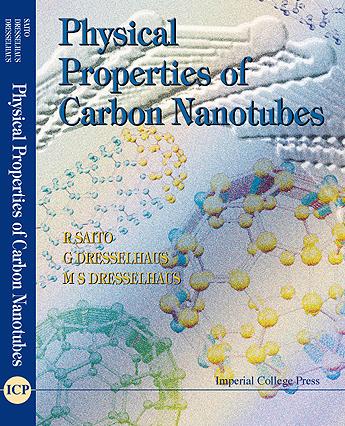 "Physical Properties of Carbon Nanotubes"
"Physical Properties of Carbon Nanotubes"
Authors: Riichiro Saito, Gene Dresslhaus, and M. S. Dresselhaus
Publisher: Imperial College Press (London) , ISBN 1-86094-093-5
Price: $25/$19 (soft cover) U.S. 258pages.
Information
Table of Contents
1 Carbon Materials
1.1 History
1.2 Hybridization in A Carbon Atom
1.2.1 sp Hybridization: Acetylene, HC=CH
1.2.2 sp2 Hybridization: Polyacetylene, (HC=CH-)n
1.2.3 sp3 Hybridization: Methane, (CH4)
1.2.4 Carbon 1s Core Orbitals
1.2.5 Isomers of Carbon
1.2.6 Carbynes
1.2.7 Vapor Grown Fibers
2 Tight Binding Calculation of Molecules and Solids
2.1 Tight Binding Method for a Crystalline Solid
2.1.1 Secular Equation
2.1.2 Procedure for obtaining the energy dispersion
2.2 Electronic Structure of Polyacetylene
2.3 Two-Dimensional Graphite
2.3.1 pi Bands of Two-Dimensional Graphite
2.3.2 sigma Bands of Two-Dimensional Graphite
3 Structure of a Single-Wall Carbon Nanotube
3.1 Classification of carbon nanotubes
3.2 Chiral Vector: Ch
3.3 Translational Vector: T
3.4 Symmetry Vector: R
3.5 Unit Cell
3.6 Group Theory of Carbon Nanotubes
3.7 Experimental evidence for nanotube structure
4 Electronic Structure of Single-Wall Nanotubes
4.1 One-electron dispersion relations
4.1.1 Zone-Folding of Energy Dispersion Relations
4.1.2 Armchair and Zigzag Nanotubes
4.1.3 Dispersion of chiral nanotubes
4.2 Density of States, Energy gap
4.3 Effects of Peierls distortion and nanotube curvature
5 Synthesis of Carbon Nanotube
5.1 Single-Wall Nanotube Synthesis
5.2 Laser Vaporization Synthesis Method
5.3 Arc Method of Synthesizing Carbon Nanotubes
5.4 Vapor Growth and Other Synthesis Methods
5.4.1 Vapor Growth Method
5.4.2 Other Synthesis Methods
5.5 Purification
5.6 Nanotube Opening, Wetting, Filling and Alignment
5.6.1 Nanotube Opening
5.6.2 Nanotube Wetting
5.6.3 Nanotube Filling
5.6.4 Alignment of Nanotubes
5.7 Nanotube Doping, Intercalation, and BN/C Composites
5.8 Temperature Regimes for Carbonization and Graphitization
5.9 Growth Mechanisms
6 Magnetic Energy Bands of Nanotubes
6.1 Free Electron in a Magnetic Field
6.2 Tight Binding in a Magnetic Field
6.3 Cosine Band in a Magnetic Field
6.4 Landau Energy Bands
6.5 Landau Energy Bands: Aharonov--Bohm effect
6.6 Landau Energy Bands: Quantum-Oscillation
7 Connecting Carbon Nanotubes
7.1 Net Diagrams of a Junction
7.2 The Rule for Connecting Two Nanotubes
7.3 Shape of a Junction
7.4 Tunneling Conductance of a Junction
7.5 Coiled Carbon Nanotubes
8 Transport Properties of Carbon Nanotubes
8.1 Quantum transport in a one-dimensional wire
8.1.1 A ballistic conductor (L << L_m, Lp)
8.1.2 Classic transport, (Lp << L)
8.1.3 Localization, (L_m << Lp)
8.1.4 Universal Conductance Fluctuations
8.1.5 Negative Magnetoresistance
8.2 Transport experiments on carbon nanotubes
8.2.1 Attaching Contacts
8.2.2 An Individual Single-Wall Nanotube
8.2.3 An Individual Rope of Single-Wall Nanotubes
8.2.4 Magneto-Transport in Multi-Wall Nanotubes
9 Phonon Modes of Carbon Nanotubes
9.1 Dynamical matrix for phonon dispersion relations
9.2 Phonon dispersion relations for two-dimensional graphite
9.3 Phonon dispersion relations for nanotubes
9.3.1 Zone folding method
9.3.2 Force constant tensor of a carbon nanotube
9.3.3 Force constant corrections due to curvature of 1D nanotubes
10 Raman Spectra of Carbon Nanotubes
10.1 Raman or infrared active modes of carbon nanotubes
10.2 Raman experiments on single-wall nanotubes
10.3 Bond Polarizability Theory of Raman Intensity for Carbon Nanotubes
10.4 Raman Spectra of Nanotubes with Random Orientations
10.4.1 Lower Frequency Raman Spectra
10.4.2 Higher Frequency Raman Modes
10.4.3 Medium Frequency Raman Modes
10.5 Sample Orientation Dependence
11 Elastic Properties of Carbon Nanotubes
11.1 Overview of Elastic Properties of Carbon Nanotubes
11.2 Strain Energy of Carbon Nanotubes
11.3 The Peierls Instability of Nanotubes
11.3.1 Bond Alternation
11.3.2 Peierls Distortion of graphite and carbon nanotubes
11.4 Properties of Multi-Wall Nanotubes
References
Index
rsaito@tube.ee.uec.ac.jp
 "Physical Properties of Carbon Nanotubes"
"Physical Properties of Carbon Nanotubes"  "Physical Properties of Carbon Nanotubes"
"Physical Properties of Carbon Nanotubes"